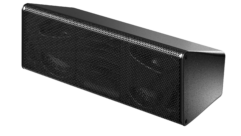Cleaning Up the House
Dec 1, 2000 12:00 PM,
Peter Mapp
EQUALIZATION AND SOUND SYSTEM PERFORMANCEIt never ceases to amaze me how many sound system installations out there do not incorporate an equalizer or appropriate equalization facilities. Over the years I have heard a range of reasons (excuses) for this. These include: “It was not in the spec,” “You only put equalizers in professional sound systems,” “All the components in our systems are individually equalized, and we don’t need an overall system equalizer,” “There was not enough money in the budget,” “There is no point in putting an equalizer into the system as people will only fiddle with it,” and, “I never use an equalizer, I don’t like the way they sound.”
Then, of course, there’s just plain ignorance, not only in terms of what equalizers actually do but why virtually every sound system installation can benefit from one. By the same token, I have all too often seen installations where better sound quality would have been achieved by putting the device into bypass rather than have the “smiley face” response or profile of the Rockies distorting the sound.
Equalization is a vast and often contentious subject covering many different fields including room acoustics, electro-acoustics, psycho-acoustics and electronics. (For the purposes of this overview, I will restrict the discussion to sound reinforcement and paging system applications, although these topics do tend to overlap into parallel areas of audio such as recording studios and A/V.) Equalization, however, is not a black art; it’s essentially an objective process, albeit one tempered by considerable subjective input and perhaps just a little magic. This article, therefore, is my view on the subject, backed by some acoustic and psychoacoustic science. Please consider it an introduction to the other articles in this issue that take a look at more specific aspects of equalization.
Equalization can be thought about in a number of ways. Two practical starting points and possible subdivisions might be:
(1) The object of the equalization, i.e., Source or System, and
(2) The form of equalizer to be employed, e.g. Broadband or Narrow band.
By source equalization I mean the electronic input to the system. This may either be from a live microphone or from a pre-recorded source such as tape or CD. Equalization may vary from the simple 2-band tone controls found on domestic audio and simple mixer/amplifier-type systems to the 3- or 4-band control of mixing consoles, most likely incorporating independent (parametric) control of filter frequency, bandwidth and amplitude (gain or attenuation). These controls allow simple broadband tonal corrections to take place and are normally set “by ear.” Where more comprehensive control is required, a graphic or multiband parametric equalizer may also be patched in or inserted into either an individual channel or group submix (for example, performer radio microphones, either to overcome microphone position-dependent pickup problems or to assist with feedback control).
System equalization, on the other hand, primarily relates to the performance of the output side, in particular to the loudspeaker and loudspeaker/room interactions. However, in smaller systems, some microphone (source) EQ may also be incorporated into the overall corrective response.
System equalizers may either be “broadband” – varying from simple 2-band conventional tone controls to 1/3-octave or 1/6-octave outboard devices – or “narrow band,” with bandwidths of 1/10-octave or less. That 1/3- or 1/6-octave equalizers are termed broadband may come as a surprise to many. (Their bandwidths are generally much greater than 1/3- or 1/6-octave; it is merely their center frequency spacing that relates to these ISO centers.) However, their broadband filters are only really suitable for general frequency response tailoring, although in the past, they have often been used for narrow-band tasks, such as feedback control. (They still are in many live situations, where instant operator control is required).
WHY EQUALIZE?Careful and appropriate equalization can transform the performance of a sound system and lead to:
– Improved naturalness
– Improved/corrected tonal balance and reduced coloration
– Extension of perceived bandwidth
– Improved gain-before-feedback margin/system gain
– Improved speech intelligibility
– Improved clarity of speech and music
– Improved system headroom
Whereas improved tonal balance, naturalness and coloration are essentially subjective attributes, improved gain before feedback and intelligibility are readily measurable. Typically, improvements in gain before feedback of around 6 dB can be expected, while intelligibility improvements of up to 25% have been reported. These are very substantial gains and clearly demonstrate the benefits of appropriate equalization. So why would any installer or designer not want to take such steps? Do they perhaps believe that their systems are so well-designed and perfect that they can not be improved? Good design, of course, is essential for a successful system, but there are a series of acoustic interactions which may occur that cannot be overcome by design alone. This is where the equalizer comes in.
If all sound system installations were carried out in anechoic chambers, then we wouldn’t need to equalize the system. The sound heard by the listener would be just that coming directly from the loudspeaker. However, installation environments are far from anechoic, and considerable interaction occurs between the direct sound and reflected sound energy within the room. The location of the loudspeaker can have a big impact on this, either by causing strong boundary interactions or by exciting particular room modes.
Figure 1, for example, shows the effect of positioning a high-quality loudspeaker with an immaculately flat anechoic response adjacent to a wall. Clearly the response is no longer flat but now exhibits large peaks and dips. Peaks of up to 6 dB are caused by constructive interference between the direct- and wall-reflected sound, whereas, theoretically, the dips or notches caused by destructive interference can be infinitely deep. In practice, however, the dips tend to be limited to around 10 to 15 dB, depending on the system andboundaries. A significant point to note about Figure 1 is that this only includes the response changes caused by a single boundary in close proximity to the loudspeaker. No other room or more distant boundary effects are included; in practice, these will serve to further modify and complicate the issue.
The graph shown in Figure 1 clearly demonstrates how the frequency response of a loudspeaker can be readily modified by its local environment. The perceived response will no longer be flat or neutral but will be highly colored with a booming bass, ragged mid-band and probably overly bright high frequencies. Immediately we can also see that the feedback margin will also have been reduced by at least 6 dB due to the peaks now introduced into the response. Furthermore, it is also a safe bet to say that the clarity of speech and music will have been adversely affected.
It is often necessary to mount or locate loudspeakers adjacent to each other. (e.g., side by side to increase the coverage of a space, or even back to back in distributed systems). Similar strong interactions can occur, usually causing an increased LF output with mid-band dips and suck-outs. Where multiple loudspeakers are employed – in large clusters or distributed systems, for example – considerable mutual coupling between loudspeakers can occur, again leading to overly emphasised bass and ragged mid-band. By the time other acoustic properties of the room or space are added (e.g., excitation of room modes and resonances) and the general radiation characteristics of the devices in question are taken into account, the measured and perceived frequency responses can be severely distorted – hence, the need for equalization. Exactly how such equalization is undertaken is still very much a matter for debate.
BROADBAND EQUALIZATIONDifferent types of systems require slightly different approaches to broadband equalization, as acoustically and psychoacoustically they don’t behave the same. There are effectively three different system types:
– Directional point-source in large space (this includes split clusters)
– Distributed sound system in large space (primarily employing low-mid Q devices)
– Systems in small spaces (e.g., studios, home theaters, conference rooms, etc.)
Cinemas and movie theaters, although primarily falling into the first category, have their own set of already established guidelines and rules, so I will not describe them.
Single and Split-Cluster Systems. Where single-point or split clusters are employed, their whole purpose is to produce as high a ratio as possible of direct to reflected sound. Thus, a listener normally hears the cluster’s direct sound followed, after a short interval, by a series of reflected sounds at diminishing levels. (See Figure 2). The object of equalization here is to optimize the spectral energy of the direct and early reflected sound reaching the listener. Now I know that there is a school of thought that says that you should equalize only the direct component, but that is not how we hear things, as the ear integrates sound arrivals over a period of time when it comes to assessing loudness and spectral balance. Therefore, in my book, the direct sound and early reflections are windowed and taken together to describe the frequency response, but usually in a time-dependent manner, which allows a longer integration time at lower frequencies than at higher frequencies.
The ability to “see” sound arrivals as a function of time is imperative to good equalization practice and requires the use of an analyzer – such as TEF, MLSSA and SMAART or SIM – that can operate in both the time domain and the frequency domain.
Another common argument is that you cannot equalize the reflections, just the direct sound. True enough. But the trick is to equalize the direct sound so that the combination of the direct sound and early reflections arriving at the ear is corrected. This can be thought of as pre-emphasizing (or more likely de-emphasizing) the direct sound so that the combination sounds right. Do not forget that at the end of the day, the ear is the final arbiter of sound balance and quality; analysers currently available, as yet, do not “hear” the sound in the same way that we do.
Distributed Systems. In high-density distributed loudspeaker systems, be they overhead ceiling-distributed or laterally mounted systems, the object of the design is for the listener to receive sound from multiple sources, with very short time arrival intervals. Sound will therefore be heard from many different directions, and, by definition, the majority of the sound heard by a listener will be from the “off axis” components. The job of equalization here is to produce a balanced result, and in my experience a longer time window is generally required. Analyzing a high-density, distributed sound system is an educational experience, where the response shown on the analyser usually holds very little resemblance to the frequency response quoted by the manufacturer! In such systems, considerable mutual coupling occurs between units, as well as strong interaction with the acoustic environment itself. Without equalization, the overall response and sound quality can be dire, whereas appropriate EQ can completely transform the situation. Figure 3 shows the energy time curve for a typical distributed system. (Compare this to Figure 2.) Here, as we can see, it is almost impossible to distinguish the direct sound from the reflected. The ratio of direct to reflected sound is almost always negative in such systems.
Small-Room Systems. In a small room, the acoustics are quite different from those of a large space. Reflections have much shorter arrival times and are consequently potentially stronger unless absorbed or diffused. The potential for strong boundary interaction is increased, and the modal density and distribution is decreased. A much-reduced direct-to-reflected sound component ratio exists, which may often be negative. In these types of installations, coloration of the sound is probably the key factor, but in conferencing or similar situations, feedback considerations may also dominate.
NARROW-BAND EQUALIZATIONWhereas broadband equalization, as discussed above, generally relates to the overall perceived spectral balance, narrow-band equalization relates more to sorting out of specific troublesome frequencies, or “ring modes.”
“Narrowbanding’ is carried out after the overall system response has been smoothed (“tamed” might be a better description in some cases). The object of narrow-band equalization is to either tune the system for optimal gain before feedback or overcome the effects of disturbing narrow-band modes that color the response and are perceived as discrete, late-decaying sounds. Whereas broadband equalization can be carried out with a 1/3-octave band analyzer, narrow-band equalization requires the use of a high-resolution device, with filter bandwidths of only a few Hertz. Narrow-band equalization is carried out in essentially the same way for the system types described above, though clearly the time span aspects are rather different between the small and large spaces.
SOME PRACTICAL ISSUESAt first appearance, equalizing a sound system would seem to be a pretty straightforward task. Apply pink noise or some other suitable test signal to the input of the system and place a measuring microphone out in the coverage area. Press “Go,” and a few moments later you have the system frequency response on the analyzer screen. A few tweaks of the equalizer controls and you’re done! Oh, if it were only that easy!
There are many potential traps when equalizing a system. Some of the most common are:
– Forgetting to set the test signal input equalization to flat
– Ditto any other sound source EQ
– Ensuring that the test signal is not overloading or clipping any part of the signal chain – not always easy to hear when using a noise-based test signal.
– Making sure there are no vacuum cleaners in the vicinity or waiting nearby, ready to start up as soon as you switch on the test noise signal. Ditto other potential noise sources such as air conditioning. (Make sure that you have at least a 10 to 15dB clear S/N ratio available.)
– Making sure that the test microphone is in the main coverage pattern of the loudspeaker. (Measuring off-axis is also essential, but you need to know what it is that you are actually attempting to correct.)
– Using the correct type of measuring microphone and ensuring that there are no filters in its input circuit that might affect the measured response.
– Locating the measuring microphone away from reflecting surfaces or areas where obvious acoustic response anomalies may occur – e.g., under a balcony or in line with the front of a balcony, in an alcove, etc.
– Ensuring that the test microphone is not picking up or measuring the unwanted effects of a stray reflection or series of reflections.
This is not always as easy as it may seem. For example, consider the simple example given in Figure 4. Clearly we need to be able to measure the response of the loudspeaker/cluster at a normal listening position (either seated or standing), but it is almost impossible to do this without including a reflection from the floor. This will arrive a few milliseconds after the direct sound from the cluster (as shown by the early reflection immediately following the initial arrival in Figure 2) and may often result in severe comb filtering occurring, as shown in Figure 5. Here, with high-resolution analysis, we can see the regular series of peaks and dips characteristic of a comb filter – indicative of an early reflection. Peaks of up to 6 dB occur, and if viewed with 1/3-octave resolution, may suggest to the unwary operator that these peaks should be attenuated as he enthusiastically reaches for the equalizer controls. Alternatively, to the unwary using a higher degree of resolution, the classic comb filter might suggest a misalignment within the cluster and be the cause of a complete re-hanging of the cluster or wholesale changes to the crossover settings and alignment.
There are techniques that can be adopted to overcome the problem, but again, care needs to be taken to ensure that you are now measuring what you think you are measuring! Also, some corrective measures may just move the problem elsewhere so that it no longer becomes as obvious, at least as far as the analyzer and “single eared” microphone are concerned.
It is beyond the scope of this article to go through a step by step guide to equalizing a system, but remember the golden rule of equalization: Use your ears and listen! If it sounds right, forget how it measures; it probably is right. Equally, if it measures right but sounds wrong, it is wrong!










